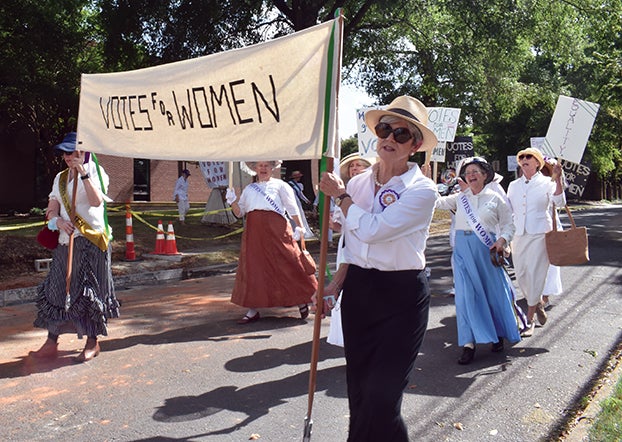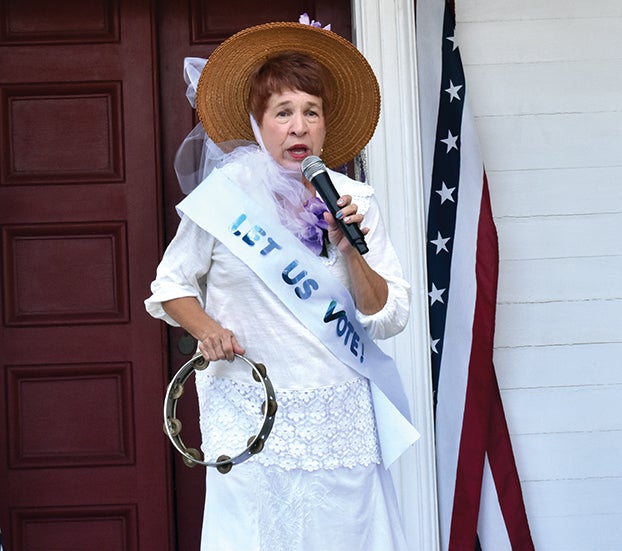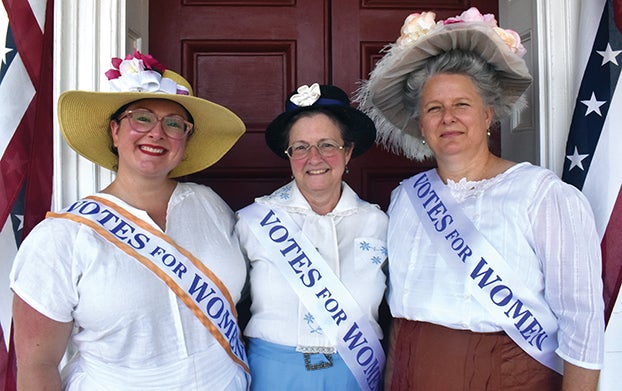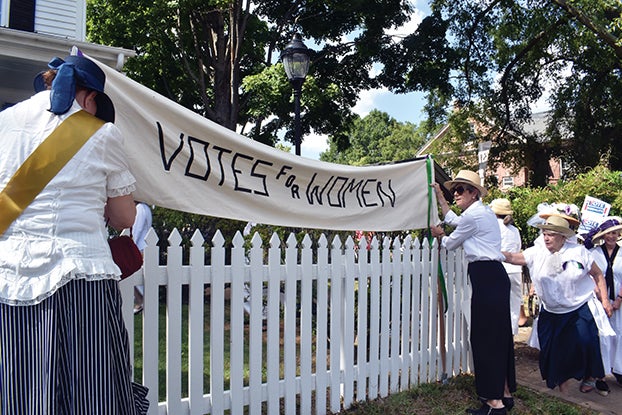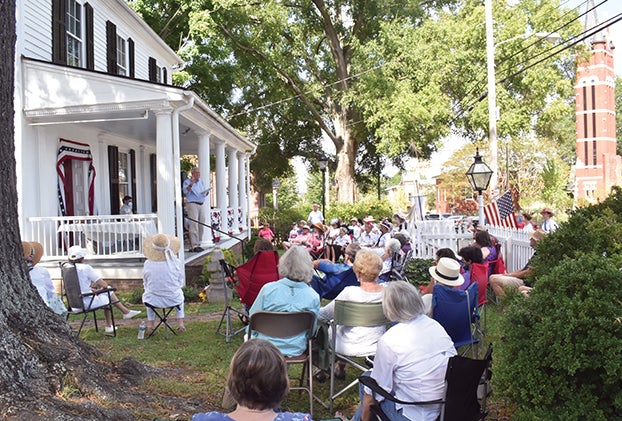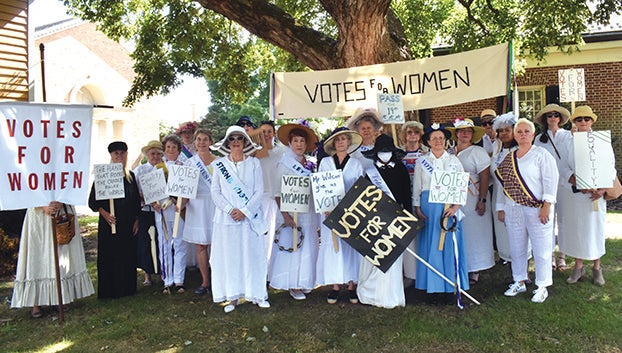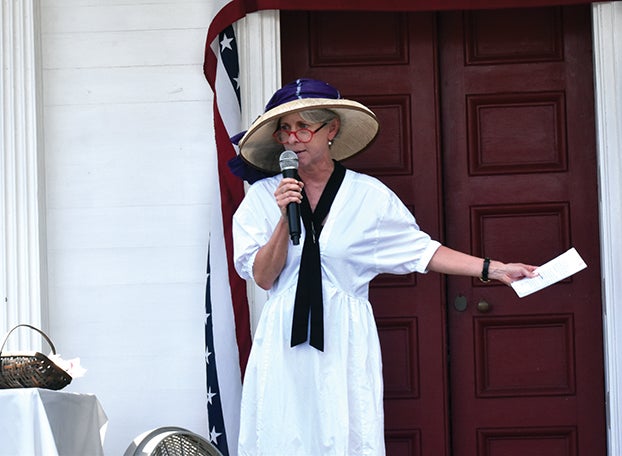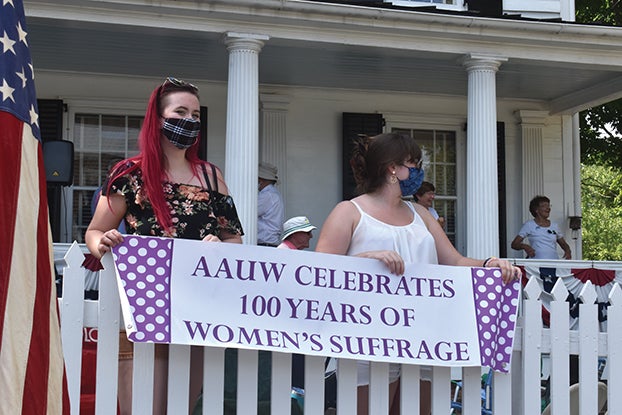Rowan Museum hosts women’s suffrage celebration at Utzman-Chambers House
Published 1:10 am Monday, August 30, 2021
SALISBURY — In an act of celebration and remembrance, about two dozen women dressed in their best suffrage attire marched in front of the Rowan Public Library and down Jackson Street on Sunday evening.
They carried signs, played instruments and chanted for equality on their way to the historic Utzman-Chambers House, where Rowan Museum recognized the 100th anniversary of the passage of the 19th amendment to the U.S. Constitution, which gave women the right to vote.
Although the 100th anniversary was technically in August, the COVID-19 pandemic forced the Rowan Museum to delay the celebration. As a result, the celebration took place on the 50th anniversary of when North Carolina finally ratified the amendment in 1971 — more than 50 years after it became federal law.
Once the suffragists finished their march, placing a large banner reading “Votes for Women,” along its white picket fence, there were several presentations on the home’s front porch. Dressed as Susan B. Anthony, one of the early leaders in the suffrage movement, Jennifer Hubbard recited a version of the impassioned speech Anthony delivered to audiences in the 1870s.
“It was we, the people, not we the white male, who formed the union and we formed it not to give the blessings of liberty, but to secure them,” Hubbard said. “Not for half of ourselves, but for all of ourselves. Not just men, but also women.”
Mary Ann McCubbin followed Hubbard’s performance by singing “Sister Suffragette,” the whimsical but important tune sung by Winifred Banks in “Mary Poppins.” After McCubbin’s song and dance, longtime Catawba College history professor Gary Freeze gave a lesson on women’s suffrage in Rowan County.
“I was pleasantly surprised to find that Salisbury had a more far reaching role in N.C.’s efforts for suffrage than I expected to,” Freeze said. “What I expected was the usual group of elite women treating it as a social party and what I found was a far broader participation and active role statewide.”
Through his research, which consisted primarily of reading articles and advertisements published in the Salisbury Post a century ago, Freeze zeroed in on a little over a dozen women who led the movement locally. Those women met for the first time in March of 1914, where they formed the Equal Suffrage League of Salisbury.
“It was not just elite women meeting together. It was women who were middle class and up coming together,” Freeze said. “That surprised me too because I was assuming an elitist model. That’s why I made a big deal about their names. Those 15 names show up over and over again.”
The Equal Suffrage League of Salisbury grew to be one of the three largest in the state, Freeze said, rivaling clubs from Chapel Hill and Raleigh. The league was led by Mary Ferrand Henderson, who served as the first legislative chairman of the Equal Suffrage League of North Carolina. Mary Ferrand belonged to the prominent Henderson family. The family, Freeze said, were also advocates for segregation during the same time period.
“The politics of this period a century ago are far more complex than we often give them credit for,” Freeze said. “This is a family that could be for segregation and for women’s rights simultaneously.”
The historical link between many women’s suffrage and segregation almost kept Jessica Moscardini from attending the 100th anniversary celebration on Sunday.
“This is an incredible celebration, but you don’t want to lose sight of the fact that it was decades before most Black women got the right to vote,” Moscardini said. “It’s an incredible victory, but I also wanted to make sure it was mentioned that that victory wasn’t equitable for all.”
Da’Tarvia Parrish spoke about the racial disparities in the women’s suffrage movement during the question and answer portion of Freeze’s presentation.
“I thought it was extremely important that I be here to represent the African-American women who were pivotal in the fight for not only women’s rights, but civil rights and overall human rights in our nation and our mosaic world,” said Parrish, who also marched in the celebration. “African Americans have not been traditionally a part of the national narrative in the women’s suffrage movement. It is imperative to note that their fight for the cause should not be forgotten or eradicated from history.”
Parrish mentioned Ida B. Wells, Mary McLeod Bethune and Sojourner Truth as several of many African-American women who worked to improve women’s rights.
In addition to the celebration, the Rowan Museum unveiled a new exhibit in the Utzman-Chambers house. Brought to life by Terry Holt and curator Evin Burleson, the exhibit focuses on the suffrage movement as a whole.
The exhibit features a picture of the letter sent by North Carolina representatives to their peers in Tennessee, stating that they would allow the Volunteer State to cast the 36th vote needed to pass the 19th amendment. The exhibit also pays tribute to the African Americans who fought for women’s rights and includes other artifacts related to the movement.
The display will remain up for several months. More information about the Rowan Museum and the Utzman-Chambers House can be found online at rowanmuseum.org.
Although it’s been 100 years since women received the constitutional right to vote, Moscardini said the fight for equality marches on.
“I think we, as women are still bargaining with the patriarchy pretty regularly,” Moscardini said.


